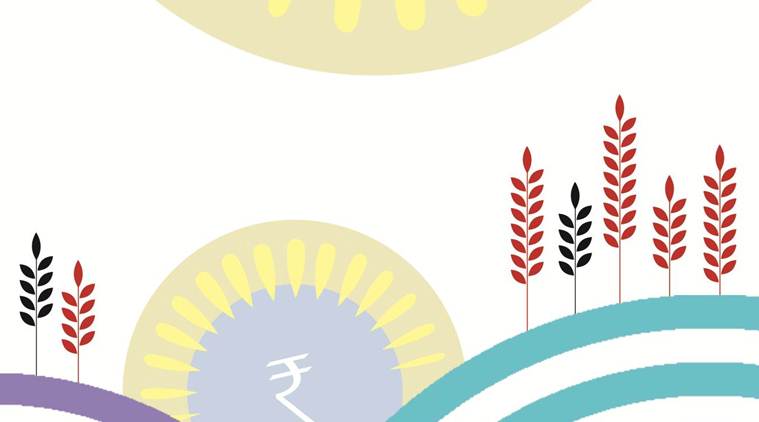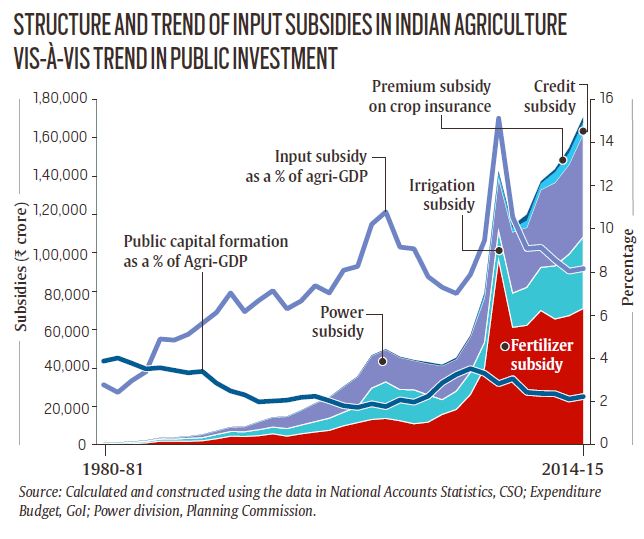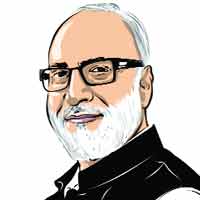From Plate to Plough: Get smarter on the farm
Supporting agriculture through input subsidies is the ‘dumb’ approach. Priority must now be given to investment in the sector and ensuring farmers have access to the latest technologies.

Public capital formation in agriculture has been declining from 3.9 per cent of agri-GDP in 1980-81 to 2.2 per cent in 2014-15 and recovered to 2.6 per cent in 2016-17, while input subsidies on fertilisers, water, power, crop insurance and agri-credit have risen from 2.8 per cent to 8 per cent of agricultural GDP during the same period. (Ilustration: CR Sasikumar)
While recently releasing the book, Supporting Indian Farms, The Smart Way (editors, Ashok Gulati, Marco Ferroni and Yuan Zhou), Union Finance Minister Arun Jaitley remarked that India needs a good blend of investments and subsidies in its agriculture policy. It was heartening to hear him say that luckily, there is not a severe constraint on resources to invest in rural areas, be it roads, water (irrigation), sanitation, and even housing. Including agri-research and development (R&D) and quality education in this list of rural investments would have ensured handsome pay offs — reducing poverty and propelling agri-growth at a much faster pace than has been the case so far. This is the clear message of the book.
Most countries support agriculture to ensure food security and/or enhance farmers’ income. India is no exception. The main policy instruments to support farmers in India include subsidised fertilisers, power, agri-credit and crop insurance on the input side, and minimum support prices for major crops on the output front. But a recent study, conducted jointly by the OECD and ICRIER, estimated that India’s trade and marketing policies have inflicted a huge negative price burden upon the country’s farmers. The Producer Support Estimate (PSE) for India works out to be minus (-) 14 per cent of the gross farm receipts for the period 2000-01 to 2016-17. This is primarily because of restrictive export policies (minimum export prices, export bans or export duties) and domestic marketing policies (due to the Essential Commodities Act, APMC, etc).
The book, however, highlights that public capital formation in agriculture has been declining from 3.9 per cent of agri-GDP in 1980-81 to 2.2 per cent in 2014-15 — it recovered to 2.6 per cent in 2016-17 — while input subsidies on fertilisers, water, power, crop insurance and agri-credit have risen from 2.8 per cent to 8 per cent of the agricultural GDP during the same period. This is the “dumb” way of supporting agriculture, as the marginal returns on subsidies are far below those from investments. The results show that expenditure incurred on Agri-R&E (Research and Education), roads or education are five to 10 times more powerful in alleviating poverty or increasing agri-GDP than a similar expenditure made on input subsidies

The graph shows that over time, the rapid increase in input subsidies has squeezed public investments in agriculture. The results of the analysis, therefore, point out that India has not got the biggest bang for its buck being spent in the agriculture space. The smarter way to support agriculture and alleviate rural poverty would have been to increase investment in agriculture at a rate much faster than subsidies.
Also, it may be noted that excessive input subsidies have caused large-scale inefficiencies in the agriculture system. For example, fertiliser subsidies, especially on urea, have led to the imbalanced use of soil nutrients. The subsidy on irrigation water has resulted in an inefficient use of scarce water. Highly subsidised power has led to over-exploitation of groundwater. Subsidy on the interest rates on crop loans has diverted substantial amounts of agri-credit to non-agricultural use. Although the new crop insurance scheme, PMFBY, has dramatically reduced the burden of premium paid by farmers, its effective implementation and the quick settlement of claims into farmers’ accounts remains a challenge.
In the light of all this, and the results presented in the table, the best blend of subsidies and investments must now give more weightage to the latter, as the finance minister indicated.

There are only a few policy suggestions that we can offer at this stage: First, investment in public irrigation is very expensive, as it involves long lags, and the gap between the potential created and potential utilised has increased over time. To give higher returns, this leaky system must be fixed, it should be made more transparent and the gap between potential created and utilised bridged. Second, the present system of delivering subsidies through the pricing policy needs to be shifted to an income policy, which could be well-targeted, and leakages minimised— on the lines of JAM trinity. Many OECD countries, as well as emerging countries such as China, are moving in that direction. Indian farms can also benefit from this move where input subsidies at least are given as DBT on a per hectare (ha) basis.
Third, investments need to be prioritised towards agricultural research and development, roads and education. Interestingly, at the global level, the private sector is leading in agri-R&D. The big six companies have been investing more than $7 billion a year, which is almost seven times the expenditure incurred by the Indian Council Agricultural Research (ICAR). So, if India needs to access that technology, it needs to develop a proper IPR regime, which is in the interest of farmers as well as investors. India has a lesson to learn from China in this aspect as well. ChemChina, a PSU, has taken over Syngenta Corporation — a leading player in crop protection and seeds — for $43 billion.
Can India make similar moves to give its farmers access to the best technologies in the world, which in turn can augment their productivity and incomes and give the nation long-term food security? Only time will tell whether India follows smart or dumb policies in its agri-space.
Gulati is Infosys Chair professor for Agriculture and Terway is Research Associate at ICRIER
For all the latest Opinion News, download Indian Express App
More From Ashok Gulati
- From Plate to Plough: Drowning in sweetnessThe sugar industry faces a crisis of plenty. Unless bold steps are taken quickly, it can prove costly to the Modi government...
- From Plate to Plough: Maharashtra vs MarketState’s decision to make MSP mandatory for traders will lead to chaos. The way forward is to treat farmers as businessmen and facilitate an environment…
- How to pay a fitting tribute to Atal Bihari VajpayeePrime Minister Atal Bihari Vajpayee’s decision to allow cultivation of Bt cotton was transformative. Modi government must fulfill his vision by enlarging the scope of…







































No hay comentarios:
Publicar un comentario